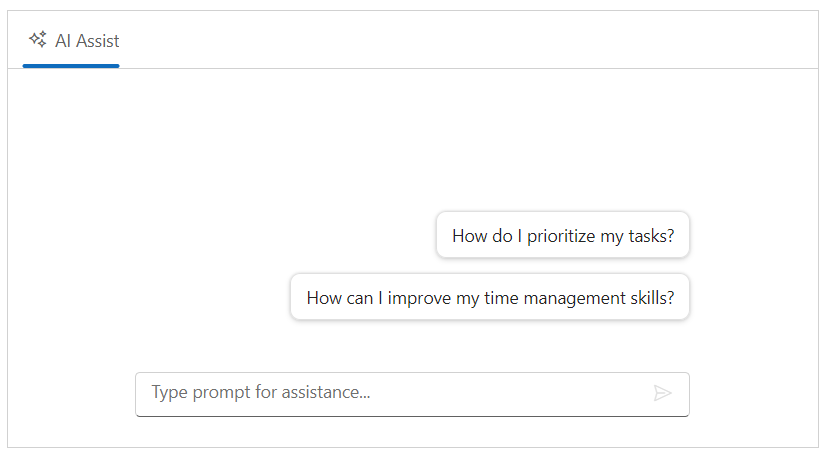Getting Started with ASP.NET Core AI AssistView control
20 Feb 20255 minutes to read
This section briefly explains about how to include ASP.NET Core AI AssistView control in your ASP.NET Core application using Visual Studio.
Prerequisites
System requirements for ASP.NET Core controls
Create ASP.NET Core web application with Razor pages
Install ASP.NET Core package in the application
To add ASP.NET Core controls in the application, open the NuGet package manager in Visual Studio (Tools → NuGet Package Manager → Manage NuGet Packages for Solution), search for Syncfusion.EJ2.AspNet.Core and then install it. Alternatively, you can utilize the following package manager command to achieve the same.
Install-Package Syncfusion.EJ2.AspNet.Core -Version 32.1.19NOTE
Syncfusion® ASP.NET Core controls are available in nuget.org. Refer to NuGet packages topic to learn more about installing NuGet packages in various OS environments. The Syncfusion.EJ2.AspNet.Core NuGet package has dependencies, Newtonsoft.Json for JSON serialization and Syncfusion.Licensing for validating Syncfusion® license key.
Add Syncfusion® ASP.NET Core Tag Helper
Open ~/Pages/_ViewImports.cshtml file and import the Syncfusion.EJ2 TagHelper.
@addTagHelper *, Syncfusion.EJ2Add stylesheet and script resources
Here, the theme and script is referred using CDN inside the <head> of ~/Pages/Shared/_Layout.cshtml file as follows,
<head>
...
<!-- Syncfusion ASP.NET Core controls styles -->
<link rel="stylesheet" href="https://cdn.syncfusion.com/ej2/32.1.19/fluent.css" />
<!-- Syncfusion ASP.NET Core controls scripts -->
<script src="https://cdn.syncfusion.com/ej2/32.1.19/dist/ej2.min.js"></script>
</head>NOTE
Checkout the Themes topic to learn different ways (CDN, NPM package, and CRG) to refer styles in ASP.NET Core application, and to have the expected appearance for Syncfusion® ASP.NET Core controls.
NOTE
Checkout the Adding Script Reference topic to learn different approaches for adding script references in your ASP.NET Core application.
Register Syncfusion® Script Manager
Also, register the script manager <ejs-script> at the end of <body> in the ASP.NET Core application as follows.
<body>
...
<!-- Syncfusion ASP.NET Core Script Manager -->
<ejs-scripts></ejs-scripts>
</body>Add ASP.NET Core AI AssistView control
Now, add the Syncfusion® ASP.NET Core AI AssistView tag helper in ~/Pages/Index.cshtml page.
@using Syncfusion.EJ2.InteractiveChat;
<div class="aiassist-container" style="height: 350px; width: 650px;">
<ejs-aiassistview id="aiAssistView"></ejs-aiassistview>
</div>Press Ctrl+F5 (Windows) or ⌘+F5 (macOS) to run the app. Then, the Syncfusion® ASP.NET Core AI AssistView control will be rendered in the default web browser.

Configure suggestions and responses
You can use the promptSuggestions property to add prompt suggestions and the promptRequest event to add responses when the prompt matches the specified prompts data otherwise, the default response will be displayed.
@using Syncfusion.EJ2.InteractiveChat;
@using System.Text.Json;
@{
var suggestions = new string[] { "How do I prioritize my tasks?", "How can I improve my time management skills?" };
var prompts = new[]
{
new { prompt = "How do I prioritize my tasks?", response = "Prioritize tasks by urgency and impact: tackle high-impact tasks first, delegate when possible, and break large tasks into smaller steps. For more assistance, feel free to ask—I’m here to help!", suggestionData = new List<string> { } },
new { prompt = "How can I improve my time management skills?", response = "To improve time management skills, try setting clear goals, using a planner or digital tools, prioritizing tasks, breaking tasks into smaller steps, and minimizing distractions. Regularly review and adjust your approach for better efficiency.", suggestionData = new List<string> { } }
};
var promptsJson = JsonSerializer.Serialize(prompts);
}
<div class="aiassist-container" style="height: 350px; width: 650px;">
<ejs-aiassistview id="aiAssistView" promptSuggestions="@suggestions" promptRequest="onPromptRequest" created="onCreated"></ejs-aiassistview>
</div>
<script>
var assistObj;
var prompts = @Html.Raw(promptsJson);
function onCreated() {
assistObj = this;
}
function onPromptRequest(args) {
setTimeout(() => {
let foundPrompt = prompts.find((promptObj) => promptObj.prompt === args.prompt);
let defaultResponse = 'For real-time prompt processing, connect the AI AssistView control to your preferred AI service, such as OpenAI or Azure Cognitive Services. Ensure you obtain the necessary API credentials to authenticate and enable seamless integration.';
assistObj.addPromptResponse(foundPrompt ? foundPrompt.response : defaultResponse);
}, 2000);
}
</script>